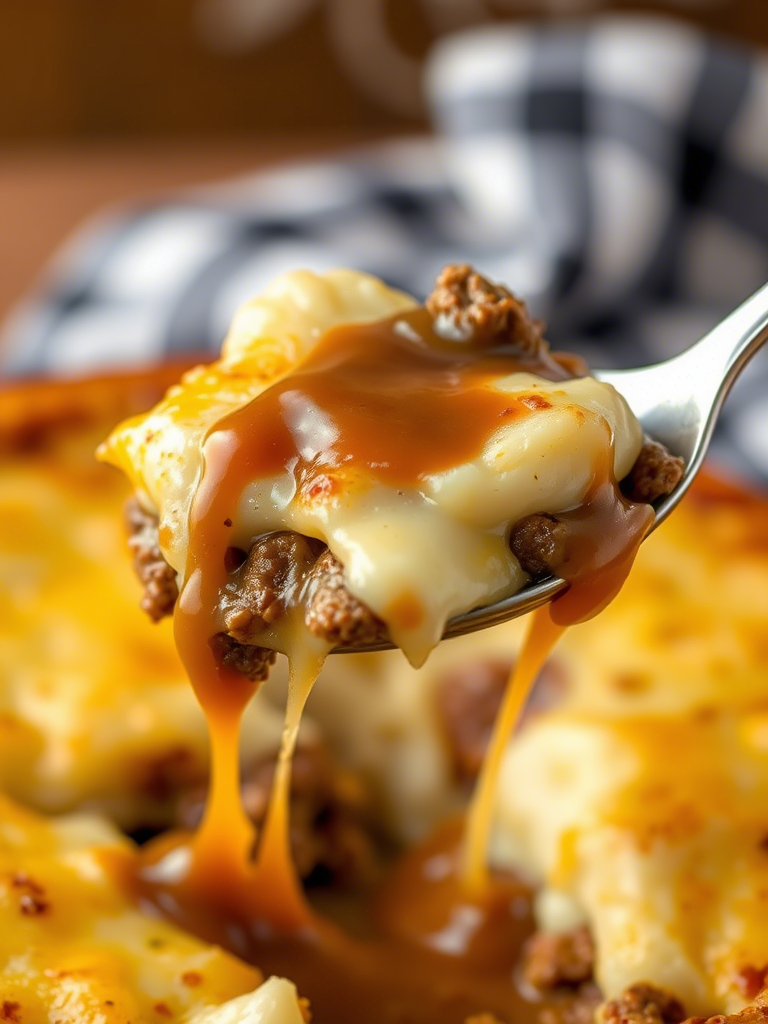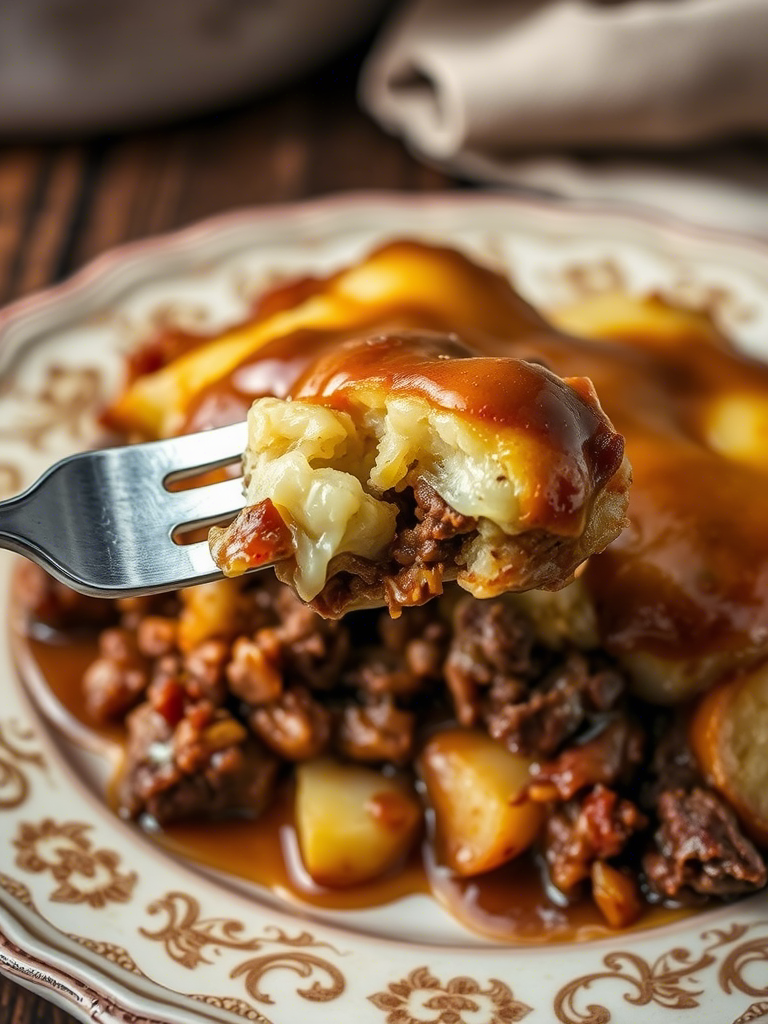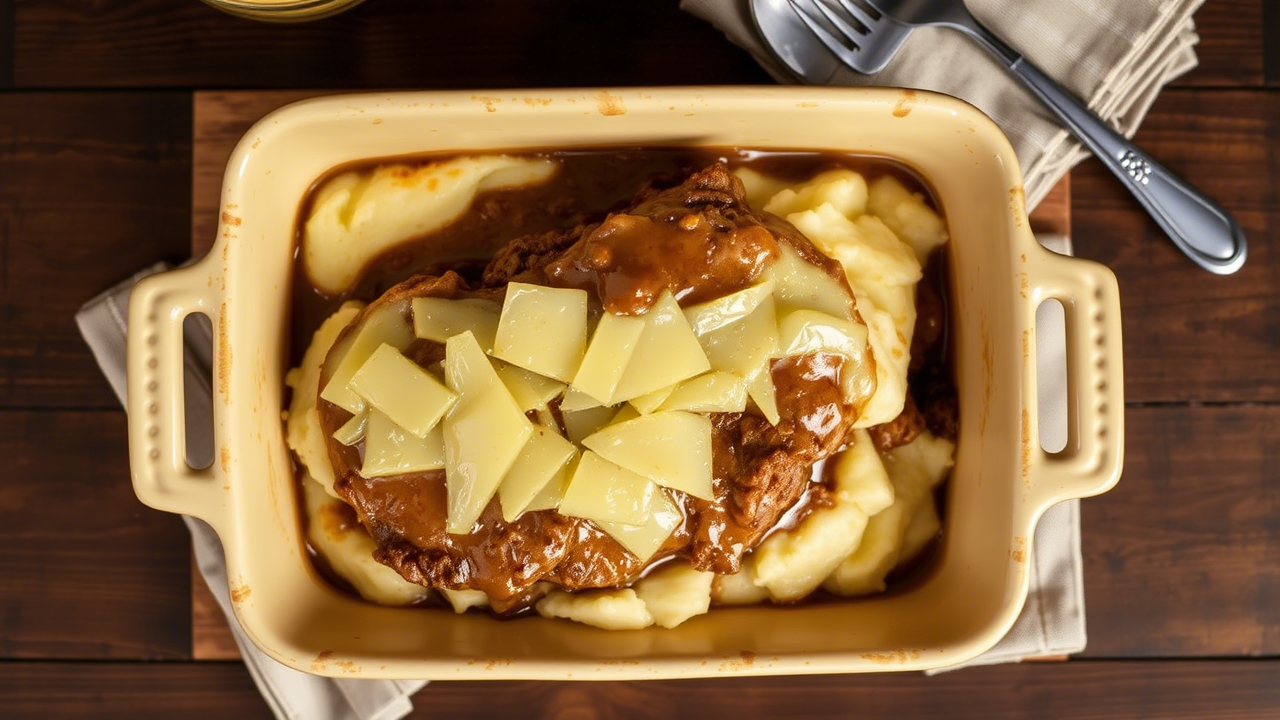Ever dig your fork into something so hearty, so old-school, so rooted in American kitchen soul, that it almost feels like a secret’s been passed to you?
That’s the Amish Hamburger Steak Bake.
This dish isn’t just a casserole. It’s a crossroad between tradition, thrift, and undeniable flavor. Humble, yes. But underestimated? Absolutely.
And if you’re in the professional kitchen or crafting elevated comfort fare for clients, there’s real value hiding under that golden-baked crust.
So let’s roll up our sleeves. Dive deep. And look at why this dish, often overlooked, might just deserve a place on your chef’s shortlist.
What Exactly Is Amish Hamburger Steak Bake?
Start simple: ground beef, onion, egg, breadcrumbs, milk. A sort of meatloaf hybrid.
Then layer it in a pan—sometimes with mashed potatoes, sometimes not. It gets topped with a savory mushroom or onion gravy. Baked until bubbling and browned.
It’s like if Salisbury steak and Shepherd’s pie decided to elope. No fancy garnish. No French reduction sauce whispering in the background. Just meat, starch, and comfort baked together.
But don’t mistake simplicity for lack of sophistication. Amish recipes are engineered for nourishment, satisfaction, and using what you’ve got. That’s precision in its own right.
Origins: It’s More Than Just “Plain Cooking”
The Amish community—largely based in Pennsylvania, Ohio, and Indiana—embraces a lifestyle that resists modern conveniences. That includes cooking.
Their food culture centers around resourcefulness. Seasonal ingredients. Cooking for large families. Stretching proteins and minimizing waste.
Hamburger steak bakes came into favor during wartime scarcity and Depression-era frugality. Ground beef was affordable. Mashed potatoes could feed a dozen. It’s a casserole born out of necessity, not novelty.
In fact, in old community cookbooks—those spiral-bound black-and-white things passed between generations—you’ll often see this dish without a real name. Just “Beef and Gravy Bake” or “Supper Meat Dish.”
That’s how rooted it is. No marketing. No branding. Just… dinner.
The Core Ingredients: A Breakdown
Let’s not pretend we’re working with foie gras here. This is a blue-collar list, but understanding each element matters.
Ground Beef
Don’t go lean. Seriously. 80/20 is ideal.
Why? That extra fat renders into the dish, keeping the texture moist and the flavor rich. Lean meat makes the final bake dry, crumbly, and flat.
And if you’re sourcing at scale—say, for a catering setup—look for pasture-raised beef. You get a noticeable difference in flavor depth, and customers do notice that mouthfeel, even if they can’t articulate it.
Egg & Breadcrumb Binder
Think meatloaf. The egg provides structure. Breadcrumbs soak up fat and moisture, making the bake tender.
Pro tip: Use fresh white sandwich bread torn by hand. Ditch the pre-packaged breadcrumbs. They can taste dusty and overly processed.
Onion
Minced raw and folded into the meat mixture. Some cooks sauté first, but raw onion in this application releases sweet, sharp juices as it bakes.
It’s not just filler—it’s a flavor release capsule.
Potatoes
Mashed, usually layered on top.
Classic Amish method: russets, peeled, boiled, mashed with butter and cream. Whip ‘em too much, though, and you’ll get gluey gloop. Keep it rustic.
Some bakes skip the mash and pour gravy over the beef slab solo. Both versions exist. It depends on the county cookbook, honestly.
Gravy
The real soul of the bake.
Traditionally, you’d use homemade beef stock. Simmered bones. Aromatics. Reduced. Thickened with flour or cornstarch.
But in most Amish kitchens? They’d use beef broth from Sunday roast scraps and a splash of milk. Maybe condensed mushroom soup if time’s tight.
From-scratch mushroom onion gravy, though, transforms this dish from church potluck to main event.
Add a splash of Worcestershire. A grind of fresh pepper. Maybe even a dab of Dijon if you’re feelin’ it.

The Bake: Not Just a Casserole
The best bakes aren’t just about what’s in the pan—they’re about how you layer.
Some folks press the beef mixture into a crust-like layer, then spread potatoes over, followed by gravy.
Others reverse it: meat on top, gravy poured before serving.
And if you’re really into detail (which you should be), consider searing the meat layer first before baking. You get a Maillard boost. Deeper browning. Savory notes that echo steakhouse vibes.
At 350°F (177°C), a 9×13 pan typically bakes for about 35–40 minutes. Rest it for 10 before slicing.
That rest period? Crucial. Skip it, and you’ll be spooning up mush.
Professional Kitchen Applications
Here’s where it gets interesting.
As a pro, you’re not just making comfort food. You’re reimagining it. Repackaging it. Elevating it without stripping it of soul.
Here’s how you can use Amish Hamburger Steak Bake in professional settings:
1. Catering
This dish holds. It reheats well. It feeds a crowd. That’s pure gold for buffet tables and event catering.
Make it in deep hotel pans. Keep warm over low steam. Garnish with chopped parsley or fried onions. Done.
2. Meal Prep Services
Freezer-friendly? Check. Portion-controllable? Yep.
Clients want healthy-ish comfort. Swap mashed potatoes for mashed cauliflower or a root vegetable medley. Use grass-fed beef. Call it “Heritage Amish Beef Bake” and you’ve got an upscale prep item with history.
3. Diner or Retro-Style Menu
People want nostalgic dishes, especially when done right.
Serve it with a ladle of scratch gravy, charred green beans, and a dinner roll. That’s $16 nostalgia plated up.
Make it cute. Call it “Grandma’s Sunday Supper Bake.”
Or edgy. “Farmhouse Beef Stack.”
Names matter more than we like to admit.
4. Farm-to-Table Concept
Got local beef and potatoes?
Feature this bake as a rotating special. List the farm sources. Let the simplicity be the star.
Diners dig dishes that feel authentic—not “crafted.” This one hits that chord hard.
Nutritional Perspective
Let’s talk stats. A classic Amish Hamburger Steak Bake (serving of ~400g) gives:
- Calories: ~550
- Protein: 28–32g
- Fat: 30–36g
- Carbs: 35–40g (depends on the potato layer)
It’s not a light meal. But you can balance.
Use leaner beef (90/10), cut the butter in the mash, or switch to a veggie-forward gravy. Toss in peas, corn, or green beans for fiber and bulk.
That way, you’re not compromising feel—but you’re improving function.

Common Misconceptions
“It’s Just Meatloaf.”
Nah. Meatloaf’s shaped, baked, glazed. Hamburger steak bakes are more of a pressed patty with casserole vibes.
They’re layered, topped, sometimes even shredded. It’s like calling mac and cheese “just noodles.”
“Too Heavy for Modern Menus.”
Depends how you frame it.
Heavy can mean satisfying. Rich can mean indulgent. We eat with our context. Rebranding helps. And portioning matters too—serve it tapas-style and watch how quickly it vanishes.
Emerging Variations Worth Watching
Chefs are already riffing on this in interesting ways.
- Smoked Amish Bake: add smoked paprika and caramelized onions, bake in a smoker-safe pan.
- Cheddar Crust Version: top the mashed potatoes with a layer of aged cheddar and broil.
- Vegetarian Mock Version: use lentils, mushrooms, and walnuts in the meat layer. Surprisingly solid texture. Surprisingly Amish, too—many of their dishes were naturally meatless during lean times.
Final Thoughts: It’s Not Just Old. It’s Gold.
The Amish Hamburger Steak Bake is the kind of recipe that never made the glossy pages. No Michelin star chef ever raved about it on camera.
But it works. It delivers. It connects. And when done right, it does all that without trying too hard.
For professionals, it’s an ideal anchor dish—malleable, scalable, recognizable, and rooted in story. You can tweak it for health, upscale it for fine dining, or keep it humble and still turn heads.
Remember: it’s not always about showing off. Sometimes, it’s just about showing up with the right flavors and making people feel fed—for real.
And this bake? It does exactly that.
Keyword integration: Amish hamburger steak bake, Amish comfort food, baked hamburger steak, traditional Amish recipe, professional catering casserole, ground beef bake.
Let me know if you’d like a printable recipe card or nutrition label to go with it.
FAQs
What is an Amish Hamburger Steak Bake?
A hearty baked casserole made with ground beef, mashed potatoes, and savory gravy, rooted in traditional Amish cooking.
Is it the same as meatloaf?
No, it’s more of a layered casserole than a shaped loaf and often includes mashed potatoes and gravy on top.
Can I make it ahead of time?
Yes, it’s perfect for prepping in advance and reheats beautifully without losing texture.
What kind of ground beef should I use?
Use 80/20 for the best flavor and moisture—leaner cuts tend to dry out.
Is this dish freezer-friendly?
Absolutely—assemble it, freeze it unbaked, then thaw and bake when ready.
Can I make it without mashed potatoes?
Yes, some versions use just beef and gravy or top with a breadcrumb crust instead.
Is there a vegetarian version of this?
Yes, lentils, mushrooms, and walnuts make a great meat-free alternative.
What gravy works best?
A homemade mushroom-onion gravy adds depth, but condensed soup versions are common too.
How long should I bake it?
At 350°F, bake it for 35–40 minutes until bubbly and browned on top.
Can I serve it in a restaurant or catering menu?
Definitely—it’s a crowd-pleaser, holds well, and can be elevated with quality ingredients.

Mariana is a passionate home cook who creates delicious, easy-to-follow recipes for busy people. From energizing breakfasts to satisfying dinners and indulgent desserts, her dishes are designed to fuel both your body and hustle.
When she’s not in the kitchen, she’s exploring new flavors and dreaming up her next recipe to share with the Foodie Hustle community.

